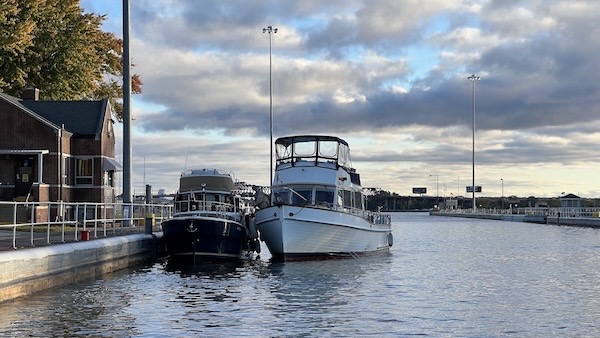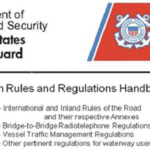An excerpt from my upcoming Great Loop book that explains how to pass through locks.
Note: I’m not blogging much lately because I’m hard at work writing a book about my Great Loop adventure. I crossed my wake in August and have been compiling information about my trip to write a travel narrative that not only tells the tale of my Great Loop cruise, but also provides information folks who want to cruise the Loop should know. I’m about 60 pages into it and have quite a bit to go, but I expect the book to be published in June in a variety of formats.
This post is an excerpt from Chapter 1 of the book and explains how to pass through locks all along the Great Loop route. – Maria
There are a lot of locks on the Great Loop and they’re not all the same. They’re designed and operated primarily for the type of traffic that goes through.
For example, the locks along the Inland Waterways, which cater to barges, are large enough to hold two or more barges with the tugboat pushing them; the ones along the Mississippi and Ohio Rivers are even larger than that. The locks on the Dismal Canal and Trent Severn Waterway cater to pleasure craft and are relatively small. The Erie Canal gets all kinds of traffic, although most of it is pleasure craft, and its locks are somewhere in between. The largest locks that you might go through on your Great Loop cruise are the ones between Lake Ontario and Lake Erie along the Welland Canal; few Loopers go that way, however; if you do decide to go that way, be aware that those locks have special rules and you’ll need to research them before you go.
The idea of a lock, of course, is to raise of lower watercraft to accommodate changes in the elevation in the river or canal. For that reason, most locks are positioned relatively close to dams, which is where the water that doesn’t go through the lock moves.
Here’s how it generally works — I say “generally” here because it’s not always the same.
You cruise towards a lock and make radio contact with the lockmaster, using whatever frequency is assigned to that lock. Sometimes he sees you coming and sometimes he doesn’t; it depends on where his office is and whether he’s paying attention to incoming traffic. He might already know you’re coming because the previous lockmaster told him — that’s common at the Flight of Five locks at Waterford on the Erie Canal and on some parts of the Trent Severn. In any case, he may or may not reply. Lockmasters can be fickle.
Outside the lock gate, there’s a signal that usually has just a red and a green light. Red means stop. If you see a red signal, you need to stop some distance from the gate and wait. The reason you don’t wait right outside the gate is twofold:
- If you are locking up (rising) in the lock, there could be turbulence as the lock empties on your side to prepare for the gates to open.
- There might be boats inside the lock that will have to get past you when the gates open.
While you’re waiting, make sure you’re prepped for the lock. That means having fenders out at or just below your rub rail, having any crew who will be outside an enclosed cabin wearing lifejackets, and having everyone in position to secure the boat to the lock wall.
When the lock is ready for you, the gates open, any boats inside the lock depart, and the light turns green. As soon as the light turns green, proceed directly into the lock at idle speed, following any boats in front of you in the order you arrived. Don’t dawdle.
Follow any instructions that the lockmaster gives you. For example, if he tells you he wants you to tie up on the port side, do it. If he tells you to move farther forward, do it. If he tells you to prep the side of your boat for another boat to raft (attach) to yours, do it. The only reason you should question a lockmaster instruction is if it is impossible or unsafe for you to do it. Communicate with him to make sure you’re all on the same page.

Here’s an example of one boat rafted to another in a lock. Although the larger boat is usually against the lock wall, it doesn’t have to be, as you can see here.
I should mention here that if the light is green and the gates are open as you approach, slow down before you reach the lock chamber and any walls leading up to it. Trust me: you don’t want to create wake that will follow you into the lock. As long as the lockmaster sees you coming and the light is green, you can enter the lock. Don’t let rushing for the lock create a dangerous situation or piss off the people in the boats already in the lock.
Once inside the lock and in position, your next job is to secure the boat to the lock wall. How you do this depends on the lock. For example, the locks on the Inland Waterways usually have floating bollards. The locks on the Erie Canal have hanging lines. You’d move the boat up so that you (if you’re solo) or one of your crewmembers can either loop a line over a bollard or grab one or more of the hanging lines. If you go through the Okeechobee canal in Florida, you’ll need to have long lines on your bow and stern and be prepared to hand or toss them to a lock tender when you are in position. He’ll secure the line to a cleat or bollard and release it for you later.
In a perfect world, you’d secure to the lock wall in at least two places: bow and stern. As a mostly solo cruiser, this is a challenge for me. I’ve found that I can often secure the boat well enough with one line on a bollard from midship or by holding a lock line from my inside helm window. Again, if any of the lock staff provide instructions, follow them. The key thing here is keeping your boat secure inside the lock as the water level changes. A loose boat in a confined space can hit other boats.
Most locks require that you kill the engine. This is to reduce exhaust fumes in the lock chamber. On the Okeechobee Canal, you must have your engine off and you cannot use your thrusters; this is because manatee may be in the lock with you.
Once all of the boats have loaded into the lock, the lockmaster will close the gates behind you. The lock will either fill or empty depending on whether you’re locking up or down. If you’re locking up and you are near the front of the lock, you might experience turbulence as the water from the waterway ahead of you pours into the lock, usually through an underwater valve. Keep the boat secure.
As the water level changes, its up to you and your crew to maintain proper slack in the line. This is easy with a floating bollard since it rises and falls with the water. But if you’re holding a fixed lock line, you may have to pay out more line or pull line in. (Did I mention that gloves are a good idea?)
When the lock chamber is full or empty (depending on whether you’re locking up or down), the gates ahead of you will open. At some locks, like along the Inland Waterways, a loud horn blows to indicate that it’s safe to depart. Start the engine, if necessary, and release your holds on the lock wall. Leave the lock with other boats in the order in which you entered (unless you’ve agreed by radio to change the order). Drive slowly, at idle speed, until you have cleared the lock and any approach walls; this prevents your wake from rocking the boats behind you.
And that’s it!
Well, mostly. Again, all locks are different. I think that what I’ve told you here covers at least 95% of the locks you’ll encounter along the Great Loop. Locking might seem hard, but it’s amazing how quickly you and your crew can develop the skills to do it safely and efficiently.
And if you’re wondering how I lock through the Erie Canal locks by myself, be sure to check out this YouTube video.


